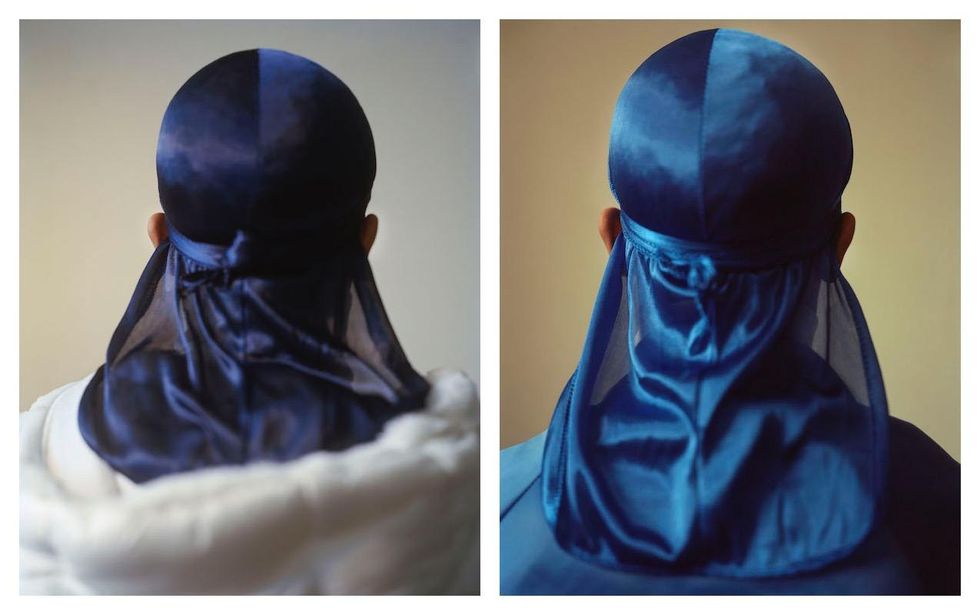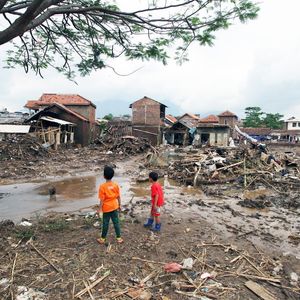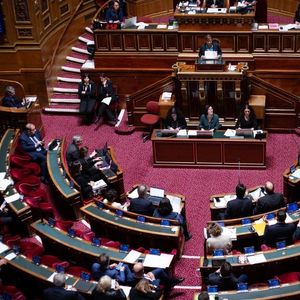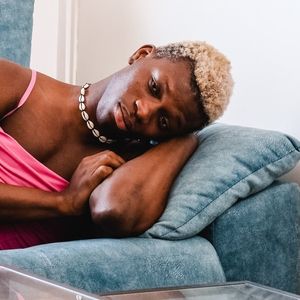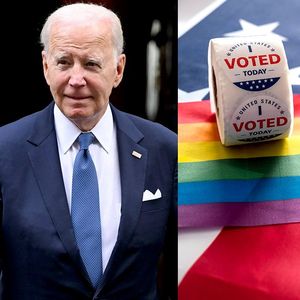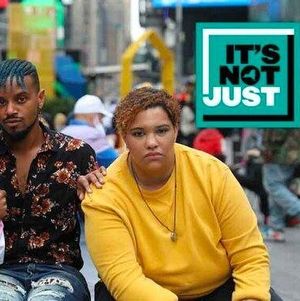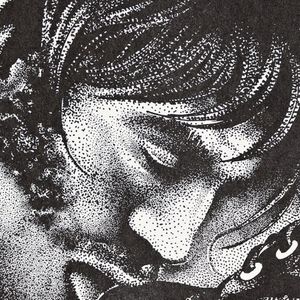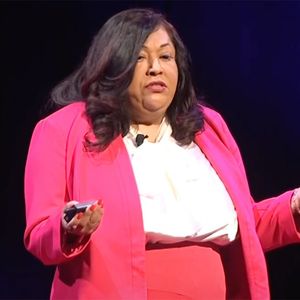John Edmonds, a queer Black photographer, has made examining identities outside of constructed social bias the core of his ongoing practice. Through images that address each of his subjects as complex individuals, rather than members of larger cultural categorizations, Edmonds' photography puts a mirror to the world, encouraging viewers to question why they've developed prejudices surrounding race, gender and sexuality.
Within this larger exploration, the 27-year-old image-maker focuses primarily on Black men in America, highlighting the vast spectrum of identities--not as a mere documenter, but as an empathetic artist, allowing each subject's own life experience to inform the direction. Across different photographic series, Edmonds' work has challenged the sexualization of Black men, tested widespread stereotypes about dress and softened mainstream depictions of masculinity.
Through Man in Polyester... (Fragmented), his 16-panel remake of Robert Mapplethorpe's Man In A Polyester Suit, Edmonds underlines the way society breaks down Black men into separate parts and fetishizes single elements, such as their penis. Chameleon, which features portraits of individuals in hoodies and hooded jackets, examines how Black men are at once invisible and scrutinized--the hooded symbol showcasing how we draw conclusions about identity based on minor, superficial cues. Edmonds' series of Du-Rags reclaims and softens the headwear as a universal, genderless symbol of Blackness, despite it being commodified today in white public spaces.
OUT recently caught up with the New York-based photographer, ahead of his solo show, Higher, which opens April 29 in ltd Los Angeles and runs through June 3. Below, we talk about challenging stereotypes, softening masculinity and celebrating humanity.
OUT: Where did you grow up and how have those experiences informed your work today?
John Edmonds: I grew up in Washington, DC in the '90s with three older sisters. My mother married and remarried in my adolescence. I didn't have a male figure to look up to when I was growing up, so much of the insistency and focus on the Black male body speaks to an absence that was felt in my personal life, rather than it mainly being a critique about the Black male body in the "canon." The women who raised me showed me a lot of love and I know that it was their nurturing the helped bring out the artist in me. So, I have always felt as though I am in touch with the "woman" inside of me through making and that this informs the way I see, feel and understand being in the world.
There's a short poem featured on your website from April, 2016. What's the poem's larger message and how do you feel it relates to your practice?
Real & Imagined,
I envision a body that is like my own
With a third consciousness
He moves quickly, smoothly- is agile
The intonation of his voice is sweet, soft, feminine
Anytime his mouth opens there is a profound message
You do not know who he is or where he is going
But you know he is in control of his own destiny
I write a lot and sometimes I consider the writing I do to be poetry. The poem you are referring to is called "Where are you going?" I can be very existentialist. I see most of the work where the figures are faceless, like in the Hoods or Du-Rags, as solitary figures looking for their place in the world--kind of like Caspar David Friedrich's notable painting, The Wanderer. It's one of my favorite paintings ever. We all question meaning and purpose--questioning is a part of life. Art, more than anything, should pose questions and open up the viewer.

Right: Untitled (Du-Rag 2) Left: Untitled (Du-Rag 3), John Edmonds (2017)
In Vision & Justice, which you link to on your site, the editor's note reads, "The endeavor to affirm the dignity of human life cannot be waged without pictures, without representational justice." How do you feel your work is bringing "representational justice" to today's world?
In Aperture's issue Vision & Justice, Sarah Elizabeth Lewis, the editor, focuses on the journey of Black people in America and considers photography's role in that journey. Celebration and triumph is a part of that journey, as well as pushing up against inequality and the violence of erasure. Thus, she creates an in-depth, evocative and complex study about Black America through pictures. It is my hope that my work also creates a complex portrait of being Black, queer and male in America, portraying the myriad of experiences, contradictions and multitudes of beauty that come with being who I am. Angela Davis said it best in Marlon Riggs's documentary Black is, Black Ain't: "Who we are is a reflection of all the places we have been." And we've been many places.
Looking at your entire body of work, what do you feel is your angle as a photographer?
I approach image making as an artist, not only as a photographer. My role is not to record or document, but to observe with understanding and empathy. Photographing allows me to be active in looking. Black subjectivity is at the core of all my work. An image is an image, just like a painting, drawing or moving image. Photography is my medium and in all the work I am first and foremost interested in the possibilities of what a picture can convey--I push that. The ambition in being an artist should be to make something you have not seen before and to open up your own mind first.
What subjects are you most interested in?
The subjects that interest me most are ones that are personal. I embrace the power of biography. As far as I'm concerned, the personal journey all artists have to go through in order to make the work is a part of the work. Ultimately, what's made public and what's kept private is compelling for me in visual art--when the work really has a story and a life outside of being "Art." Everything [and] everyone I photograph I feel connected to, so I guess you could say the artist-model dynamic is inherently a conversation I have always been invested in.

Man in Polyester... (Fragmented), John Edmonds (2016)
With Chameleon and Fragments, there's a level of anonymity and mystery to the imagery--same with the Du-Rags. Why?
On my website, Chameleon is from the time period that I completed my MFA at Yale University. It is a chapter that contains several bodies of work, including the Hoods series. Fragments, which uses the infamous photograph, Man in Polyester Suit, as a point of reference, are two different photographs of my friend Tylan unzipping the fly of his pants compiled into one image that makes one body. In all the work under Chameleon, there is a play of reveal and non-reveal, a considering of how the Black male is both hypervisible and invisible in public space. It's like I'm playing a game of hide and seek. And in that, I play instigator in society's understanding of race, gender, sexuality and performance. Fashion and presentation are always considered. I don't give it all away because I want people to work to see these individuals. You may even say I want people to work to see themselves [and] their assumptions. I feel connected to everyone I chose to make a photograph of, even strangers, so there is always a level of protection I have over anyone I work with.
What's the larger mission behind Chameleon and Fragments?
In Fragments, I deconstruct the body to make a statement and critique about the Black male body in Mapplethorpe's Man in Polyester Suit. The fragmentation riffs off of society's obsession with the Black male body in terms of parts--the reducing and obsession with the phallus, ass [and] abs... I'm debunking a myth. And the guy I am photographing is a close friend, who is also black and queer, so we're doing it together. And there is no phallus--these are our parts for us to keep and see for our pleasure, at our discretion.
When I made the work under Chameleon, I considered mutability as a tactic for survival, as chameleons change and adapt to their settings. I do this through the way the individuals are dressed and gesture. In that work, status and class are addressed through the way in which the subject is dressed--two factors that are often erased when the topic of race and gender are considered.

Left: Untitled (Hood 1), Right: Untitled (Hood 4), John Edmonds (2016)
Do you think the "hood" and "du-rag" has become a social or political symbol?
I think the hood is unavoidably a social and political symbol. When I made the Hoods pictures, I made them because I was curious about how I look from behind in public space. I was often wearing hoods while I was living in New Haven--for practical reasons, it gets very cold in the winter--but also because I felt it described my temperament. When you are exhausted, you want people to leave you alone. You cover yourself. You wear sunglasses when it's overcast and hats indoors. I put these hoods onto other people, ranging in race, ethnicity, gender [and] age to consider the way in which we name and identify others we cannot see--both figuratively and literally speaking. I don't think of the du-rag as a political symbol because the impetus to make the work is not the same as the Hoods pictures. And du-rags are less defined in contemporary visual culture, even though they have a very rich history.
Do you feel your work is softening depictions of Black masculinity?
Yes, I do. But there are others doing this work throughout culture in other ways, which is exciting! On the Internet the hashtag #softmasc is trending. Moonlight, the best film of 2016, played a major role in showing the layers of Black masculinity and manhood. Papi Juice, one of my favorite Brooklyn-based parties for queer people of color, deemed their kick off theme for this spring as "Soft Papi." Thomas Hill, one of my favorite young poets who writes under the alias "tomcatpur," uses the term within much of his practice to foster community. What I love most about this movement right now is that Black masculinity is being seen as a spectrum--not a polarity to femininity or "androgynous style." Think about when Cam'ron and Dip-set were wearing pink du-rags and baby blue furs in the early 2000s!
Related | A Moonlight Revolution: The Black Queer Experience Comes of Age in America
You also printed Du-Rags on soft, flowing fabric...
The Du-Rags were printed on a Japanese silk mainly to replicate the materiality of a du-rag, but also to animate the photographs in a way that they have a life of their own. They flow and move like they have their own breath.
Do you think softened masculinity is becoming more socially acceptable?
It is becoming more socially acceptable, but there have been people who have been open to different types of gender expression for ages. I also think that there are more people who are open to seeing male in female and female in male, and everything in between. The fact of the matter is that we are all fluid.

Marcus with the Sacred Heart, John Edmonds (2012)
What inspired you to create the Du-Rags series? Is this something you're continuing to explore during your current Miami residency?
I first made the Du-Rags mainly because of my obsession with the adornment of the head. I have so many memories attached to du-rags because my mother wore them when I was growing up. Along with many of my peers, I started wearing them too around 11 or 12 years old. Most things that people connect to their childhood have happiness and beauty attached to it. In Du-Rags I like to think that despite whether the individual is male of female, they represent a universal Black body that knows no bounds to gender. And, as I've mentioned before du-rags are less symbolically fraught than hoods. I have continued to make this work in Miami, and consider du-rags as cross cultural in how they also function as a veil similar to a hijab or burka. Du-rags are coming back in and it's a symbol that has a growing interpretation.
You've been quoted before as saying you're interested in dissecting the "psychology of color." Explain that practice.
We associate certain colors with gender and emotion. Many people may say they don't agree, but that's because it is so rooted in our way of thinking. For example--blue being stereotypically a boy's color, or representing calmer emotions. There is much blue in the Hoods pictures, which is why many still insist on describing the individuals as male when in fact, some of them are not.
How do queer qualities manifest throughout your photography?
Most of the people I photograph are Black and male, but I see them as individuals with their own autonomy first. You are who you are in the world--we all have identities, I'm not arguing against that. But that's not all we are, and the work does a great job at showing that. I photograph men I encounter that I am attracted to, interested in and that I do not want to forget--I'm a collector in that sense. The attractions vary from emotional, sexual and fraternal. So I guess the "queer" aspect of my work is that while I do recognize the identity of the individuals, I see them as infinite in their being. Mickalene Thomas says it best--she sees the Black women in her work as everything because she knows that she's everything! My work is about real people, real experiences and real life.
Why do you think your work is important in our world today?
Humanity matters.




